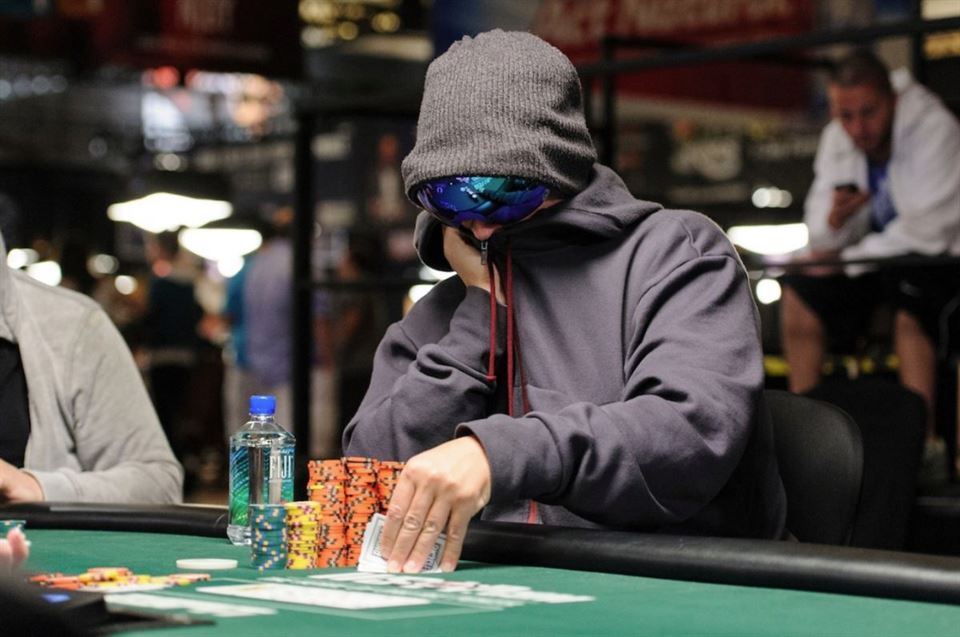Transitioning from grinding online poker to finding success in live circuits can be a significant change for professional players. While the online grind offers convenience and comfort, the live circuit brings its own set of challenges and opportunities. In this article, we will explore the lifestyle transition that poker players undergo when making the shift from online play to thriving on the live circuit.
Transitioning from Online Poker to Live Tournaments: A Guide for Success
For many professional poker players, the transition from online grind to live circuit success is a natural progression. While online poker offers convenience and accessibility, there is something unique and exhilarating about competing in live tournaments. However, making this transition requires careful planning and a different set of skills. In this guide, we will explore some essential tips for successfully transitioning from online poker to live tournament play.
Firstly, it’s important to understand that live tournaments have a different pace compared to online games. In online poker, decisions are made quickly, and multiple tables can be played simultaneously. In contrast, live tournaments require patience and a focus on each individual hand. Take your time to observe the table dynamics, study your opponents’ tendencies, and make well-thought-out decisions. Remember, you’re no longer playing against anonymous screen names but real people sitting across from you.
One key difference between online and live poker is the ability to read physical tells. While online players rely heavily on bet sizing and timing patterns, live players give away valuable information through their body language and facial expressions. Pay close attention to these cues as they can provide insights into your opponents’ hands and intentions. Developing your reading abilities takes practice and observation, so make sure to sharpen this skill during your transition.
Another crucial aspect of successful live tournament play is bankroll management. In online poker, it’s easy to reload and continue playing after losing a few buy-ins. However, in live tournaments, a single buy-in represents a significant investment. Therefore, it’s vital to approach bankroll management with discipline and caution. Set aside a separate bankroll specifically for live tournaments and ensure that you have enough funds to cover travel expenses, accommodation, and buy-ins without putting unnecessary strain on your finances.
Furthermore, adapting to the slower pace of live tournaments requires mental fortitude. Online players are accustomed to the fast-paced action and instant gratification that comes with winning pots quickly. In contrast, live tournaments can be grueling, with long hours and periods of inactivity. It’s essential to stay focused and maintain a positive mindset throughout the tournament. Be prepared for swings in luck and variance, as these are inevitable aspects of live poker.
Additionally, networking is a vital aspect of succeeding in the live poker circuit. Unlike online poker, where interaction is limited to chat boxes, live tournaments provide an opportunity to meet fellow players, industry professionals, and potential sponsors. Take advantage of breaks and downtime to engage in conversations, exchange contact information, and build relationships within the poker community. Networking not only opens doors to future opportunities but also helps you learn from experienced players who have already made the transition successfully.
Lastly, it’s crucial to continuously improve your game by studying and analyzing your performance. While online poker offers a wealth of resources, such as training sites and hand history reviews, live tournaments require a different approach. Record your hands, take notes on opponents’ tendencies, and review your play after each tournament. Seek feedback from other players or hire a coach to help identify areas for improvement. By dedicating time and effort to study and self-reflection, you’ll enhance your skills and increase your chances of success in live tournaments.
In conclusion, transitioning from online grind to live circuit success is an exciting journey for professional poker players. By understanding the differences between online and live poker, focusing on bankroll management, developing reading abilities, maintaining mental fortitude, networking, and continuous learning, you can position yourself for success in the live tournament arena. Embrace the challenge, enjoy the experience, and let your passion for the game drive you towards achieving your goals.
The Pros and Cons of Switching to a Poker Lifestyle: Online Grind vs. Live Circuit
Poker has always been a popular game, attracting players from all walks of life. In recent years, the rise of online poker has made it more accessible than ever before. With just a few clicks, anyone can join a virtual table and test their skills against players from around the world. However, for some players, the allure of the live circuit is too strong to resist.
Making the transition from online grind to live circuit success is not an easy task. There are pros and cons to both styles of play, and understanding these differences is crucial for any aspiring poker professional.
One of the main advantages of playing online poker is the convenience it offers. With no need to travel to a casino or poker room, players can enjoy the game from the comfort of their own homes. This means that they can play whenever they want, without having to worry about finding a suitable venue or dealing with travel expenses. Additionally, online poker rooms often offer a wide variety of games and stakes, allowing players to find a table that suits their preferences.
Another advantage of online poker is the ability to multi-table. Many skilled players are able to play multiple tables simultaneously, increasing their potential for profit. This is something that simply isn’t possible in a live setting, where players must focus on one table at a time. Multi-tabling requires excellent concentration and decision-making skills, but for those who can handle it, the rewards can be significant.
However, there are also drawbacks to playing online poker. One of the biggest challenges is the lack of physical tells. In a live game, players can observe their opponents’ body language and facial expressions, which can provide valuable information about their hand strength. Online players must rely solely on betting patterns and timing tells, which are often less reliable indicators. This makes reading opponents more difficult and puts a greater emphasis on mathematical calculations and strategic thinking.
Furthermore, online poker can be more prone to distractions. Players may be tempted to check their emails, browse social media, or engage in other activities while playing. This can lead to a lack of focus and poor decision-making, ultimately costing them money. In a live game, players are typically more engaged and less likely to succumb to distractions.
On the other hand, the live circuit offers its own set of advantages. One of the main benefits is the opportunity for social interaction. Poker is a game that thrives on human interaction, and playing in a live setting allows players to engage with others and build relationships. The live circuit also provides a sense of camaraderie among players, as they compete against each other for prestigious titles and large cash prizes.
Additionally, live poker allows players to exploit physical tells to gain an edge over their opponents. Reading body language and facial expressions can provide valuable insights into an opponent’s hand strength and intentions. Skilled players can use this information to make better decisions and increase their chances of success.
However, there are drawbacks to playing in the live circuit as well. Traveling to different tournaments can be time-consuming and expensive. Players must also deal with the added pressure of performing well under the watchful eyes of spectators and cameras. Nerves and anxiety can impact decision-making and lead to suboptimal play.
In conclusion, making the transition from online grind to live circuit success requires careful consideration of the pros and cons of each style of play. While online poker offers convenience and the ability to multi-table, live poker provides opportunities for social interaction and exploiting physical tells. Ultimately, it comes down to personal preference and finding the style of play that suits you best.
Adapting to the Poker Lifestyle: Tips for a Smooth Transition from Online to Live Play
Poker is a game that has been played for centuries, and with the rise of technology, it has become increasingly popular in the online world. Many players have found success grinding it out on virtual tables, honing their skills and building their bankrolls. However, there comes a time when a player may feel the need to transition from the online grind to live circuit play. This transition can be both exciting and challenging, as there are many differences between playing online and playing in a live setting.
One of the first things to consider when making the switch from online to live play is the pace of the game. Online poker moves at a much faster pace than live poker, with hands being dealt quickly and decisions needing to be made within seconds. In contrast, live poker is a more relaxed and slower-paced game, with players taking their time to make decisions. It’s important for players to adjust their mindset and adapt to this change in tempo. Patience is key in live play, as players will often have to wait longer for playable hands and navigate through larger fields.
Another difference between online and live play is the ability to read opponents. When playing online, players rely heavily on statistical data and betting patterns to make decisions. However, in a live setting, players have the opportunity to observe their opponents’ physical tells and facial expressions, which can provide valuable information about the strength of their hand. It’s important for players to pay close attention to these cues and use them to their advantage.
In addition to reading opponents, players must also be mindful of their own behavior at the table. Online players are used to hiding behind a screen and can sometimes forget that they are now in a live environment where every action is visible. It’s important to maintain composure and avoid giving away any tells or emotions that could give opponents an edge. Staying calm and focused is crucial in live play, as it allows players to make rational decisions and avoid making costly mistakes.
Another aspect of the live poker lifestyle that players must adapt to is the physical demands of playing in a live setting. Online players are accustomed to sitting comfortably at home, playing for hours on end without any physical strain. In contrast, live play requires players to sit for long periods of time, often in uncomfortable chairs, and endure the mental and physical fatigue that comes with it. It’s important for players to take breaks, stretch, and stay hydrated to maintain their focus and stamina throughout a tournament or cash game session.
Lastly, players must also be prepared for the social aspect of live play. Unlike online poker, where players can remain anonymous and interact through chat boxes, live play involves face-to-face interaction with opponents and other players at the table. This can be both intimidating and exciting, as players have the opportunity to network and form connections within the poker community. It’s important for players to be respectful, friendly, and maintain good sportsmanship at all times.
In conclusion, transitioning from online grind to live circuit success requires players to make several adjustments. Adapting to the slower pace of the game, learning to read opponents’ physical tells, maintaining composure, managing physical demands, and embracing the social aspect of live play are all essential skills for a smooth transition. With practice and experience, players can successfully navigate these differences and find success in the live poker world. So, if you’re an online player looking to take your game to the next level, don’t be afraid to step out from behind the screen and embrace the challenges and rewards of live play.
From Grinding Online to Thriving in Live Poker: Strategies for Transitioning Successfully
Poker has been a popular game for decades, and with the rise of online poker platforms, it has become more accessible than ever before. Many players have honed their skills and built successful careers grinding online, but there comes a point where some may feel the need to transition to the live circuit. This shift can be challenging, as the dynamics of live poker differ significantly from those of online play. However, with the right strategies and mindset, one can make a smooth and successful transition.
Firstly, it is essential to acknowledge the differences between online and live poker. Online poker is fast-paced, with multiple tables and hands being played simultaneously. It requires quick decision-making and a solid understanding of mathematical probabilities. On the other hand, live poker is slower and more focused on reading opponents’ physical tells and body language. Adapting to this change in pace and playing style is crucial for success.
One key strategy for transitioning successfully is to start by playing smaller stakes live games. While online grinders may be used to playing high-stakes games, the live circuit presents different challenges that require adjustment. By starting at lower stakes, players can get accustomed to the new environment without risking a significant portion of their bankroll. This approach allows for gaining experience and building confidence gradually.
Another important aspect of transitioning from online grind to live poker success is developing strong observation skills. In an online setting, players rely heavily on statistics and patterns to make decisions. However, in live poker, these tools are less reliable, and one must learn to read opponents’ actions and behaviors. This includes observing betting patterns, facial expressions, and body language to gain insight into their opponents’ hands. The ability to accurately assess opponents’ intentions and emotions is a valuable skill that can greatly enhance one’s chances of success in live play.
Furthermore, managing one’s bankroll is crucial during this transition period. Online grinders often have a solid understanding of bankroll management, but live poker can be more unpredictable. The variance in live games tends to be higher, and the cost of entry for tournaments is generally higher as well. It is essential to set aside a separate bankroll specifically for live play and ensure that it is properly managed to withstand potential swings and losses.
Additionally, building a strong network within the live poker community can greatly contribute to one’s success. Online grinders may have been accustomed to playing anonymously, but in live poker, establishing connections and relationships with other players can provide valuable insights and opportunities. Attending live events, participating in cash games, and engaging in conversations with fellow players can lead to valuable advice, collaboration, and even sponsorship opportunities.
Finally, maintaining a positive mindset throughout the transition process is crucial. Live poker can be mentally challenging, especially during downswings or when facing tough opponents. It is important to stay focused, patient, and resilient. Developing a routine that includes physical exercise, meditation, or other stress-relieving activities can help manage emotions and keep a clear mind at the table.
In conclusion, transitioning from online grind to thriving in live poker requires adapting to the differences in pace, playing style, and dynamics. Starting at smaller stakes, developing observation skills, managing one’s bankroll, building a network, and maintaining a positive mindset are all crucial elements for success. With dedication, practice, and a willingness to learn, online grinders can make a smooth transition to the live circuit and thrive in the world of live poker.
Making the Move: How to Navigate the Transition from Online Poker to Live Circuit Triumph
In recent years, online poker has seen a surge in popularity, with players flocking to virtual tables for the convenience and accessibility it offers. However, many ambitious players aspire to take their game to the next level by transitioning from the online grind to live circuit success. This transition can be challenging, but with the right approach and mindset, it is entirely possible to thrive in the live poker arena.
One of the first things to consider when making the move from online poker to live circuits is the adjustment in playing style. Online poker tends to be more fast-paced and aggressive, while live poker often requires a more patient and strategic approach. It’s important to adapt to the slower pace of live play and not get frustrated or impatient during long stretches of inactivity. Developing a strong understanding of the dynamics of live poker, such as reading physical tells and adjusting to different playing styles, will greatly enhance your chances of success.
Another crucial aspect of transitioning successfully is managing your bankroll effectively. In online poker, it’s relatively easy to top up your account if you go on a losing streak. However, in live tournaments, you need to carefully plan and allocate your funds to ensure you can weather any downswings without going broke. Setting aside a dedicated bankroll for live play and sticking to strict bankroll management principles will help you avoid unnecessary financial stress and allow you to focus on your game.
Building a solid network of fellow poker players is also essential in navigating the live circuit. Unlike online poker where interactions are limited to chat boxes, live poker provides ample opportunities for networking and learning from experienced professionals. Engaging in conversations at the table, attending poker conferences, and joining local poker clubs or communities will expose you to valuable insights and advice that can significantly improve your game. Additionally, having a supportive network of like-minded individuals can provide the necessary motivation and encouragement during challenging times.
Furthermore, it’s crucial to maintain a disciplined and focused mindset when transitioning to live poker. Online play allows for multitasking and distractions, but in a live setting, your undivided attention is required. Avoid getting caught up in conversations or being distracted by external factors that may impact your decision-making process. Developing mental fortitude and staying emotionally balanced even during bad beats or tough stretches will set you apart from less composed players and give you an edge on the live circuit.
Lastly, continuous learning and improvement are paramount in your journey from online grind to live circuit success. Invest time in studying advanced poker strategies, analyzing hand histories, and reviewing your own gameplay. Utilize resources such as books, training sites, and coaching to refine your skills and stay ahead of the competition. Remember, poker is a game of skill, and the more knowledge and expertise you acquire, the better equipped you’ll be to make profitable decisions at the table.
In conclusion, making the transition from online poker to live circuit success requires adaptability, financial discipline, networking, mental focus, and a commitment to continuous learning. By adjusting your playing style, managing your bankroll effectively, building a strong network, maintaining a disciplined mindset, and continuously improving your skills, you can successfully navigate the shift and thrive in the live poker arena. Embrace the challenge, embrace the opportunity, and let your passion for the game fuel your journey towards achieving your poker dreams.




